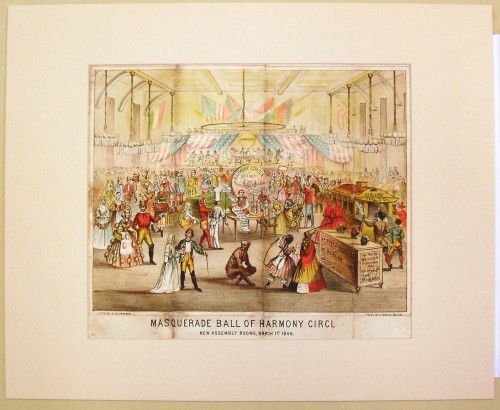The Dancing Schools of Baltimore’s Jewish Society

 Article by Gil Sandler. Originally published in Generations – 2004: Recreation, Sports & Leisure. This particular issue of Generations proved wildly popular and is no longer available for purchase.
Article by Gil Sandler. Originally published in Generations – 2004: Recreation, Sports & Leisure. This particular issue of Generations proved wildly popular and is no longer available for purchase.
Part I: Learning the Foxtrot
“Boys and girls, we will now learn the foxtrot. Put your left foot out … take your right foot and put it alongside your left …”
It is Saturday afternoon in 1942; we are on the second floor of 6 West Eager Street, north side, just west of Charles Street. The site is now a parking lot – directly across from what today is the Hippo Club. About 20 well-scrubbed and well-dressed young people are standing in a circle gathered around the speaker, and listening in rapt attention; a record is playing Glenn Miller’s “Moonlight Serenade.” The speaker, who is in fact the instructor, is Aileen Straus, and together with her partner Bea Goodhart, they are teaching social dancing to the children of the families who make up Baltimore’s Jewish patrician class and those that aspire to belong to it. In this pre-fifties era, some mastery of social dancing is thought to be a requirement for those young people who expect to take their place in the Jewish social circle prescribed for them by their parents.
Bennard Perlman, at age 13 in 1942, is one of the boys in the circle, and he is trying his very best to follow Ms. Straus’s instructions – without too much success. “I had to think a lot about what I was doing,” he recalls. “Here I was, an accelerated honor student in School #49, and I am having trouble learning how to put one foot in front of the other in time to ‘Moonlight Serenade.’ I attended dance class from the time I was 12 until I was 14 – when I was a freshman at City College. We first learned the fox trot, then the waltz, and so help me, jitterbugging. As we progressed, we moved from Saturday afternoon to Friday night, then, for those of us who had hung in, Saturday night – the big night!”
“In order to get all of the guys and all of the girls involved – so that nobody would be a wallflower – our teachers created the ‘shoe dance.” Each of the girls was asked to take off one shoe and place it in the center of the floor. The guys were then asked to pick up one of the shoes and then go find its mate – on one of the girls. When you found your shoe’s mate, you found your next dance!”
“In my class were, among others, Jill ROten Myers, Liz Kohn Moser, Ellen Levi Zamoiski, Jane White Markle, Dona Coplin, Midge Kaufman, David Blum and Margie Blum Jaffe, Eugene Schreiber, Bobby Rappaport, Disney Offit, Richard Millhaiser, and Babs Grinsfelder.”
Walter Sondheim’s may be the oldest memory of Baltimore’s Jewish dancing classes. “It was called ‘Mr. Tuttle’s,” he recalls. “And in the years I went there, from about 1918 to 1920, it was located on the south side of North Avenue, just east of Charles Street, on the second floor. All of the kids in the class were from Park School. What I remember most is that we were taught the proper way to bow to the girls, on being introduced. I seem to remember a rhythm – one, two, three, four, slide…something like that. I think we all were sent to dancing school because our parents in that social circle thought it was the right thing to do. Given their aspirations for us, I guess it was.”
“Dancing school” for the teen children of Jewish Baltimore’s patrician class, and those aspiring to becoming members of it, traces its origins to Baltimore’s German Jewish community of the mid-to-late nineteenth century, when that population unapologetically embraced the structure of the across-town Protestant society. Barred from joining it, they simply imitated.

The first dancing school for the children of Baltimore’s wealthy German Jews was founded in 1860. In October of that year, the school held its first dance for the children and their parents in Old Oak Hall on East Baltimore, and a tradition was born. Beginning with this first ball, the group adopted the name “Harmony Circle.” The ball, which became an annual event and the highlight of Jewish society’s social season, was an attempt to borrow from the cachet of the “Harmonie Club” in New York, which, beginning in the 1850s and at least for another century, was the most prestigious of the Herman Jewish New York social clubs.
Baltimore’s Harmony Circle would become not only a showcase for the dancing school students, but also for its debutante ball, where the daughters of the member families would “come out” and be introduced to the sons of the members. The founding officers of Baltimore’s Harmony Circle were Louis Hecht, Charles Brownold, Nathan Hirshberg, Charles G. Hutzler, and Bernard Behrens.
A grand dame of the patrician Jewish world, Mrs. Stanford (Marie) Rothschild, writing in a 1969 memoir, explained why she thought the German Jews of that time started their own dancing school and debutante balls: “When the old Baltimore German Jewish families had gained status, they thought it time to have formal status socially. Not being eligible for the Protestants’ Junior Assembly, they decided to have a similar set for what they thought were important Jewish families.” Although the Jewish debutante “coming out” parties were abandoned in the late 1930s as the German Jewish community refocused its attentions on the developing tragedy of German Jewry, the descendants of that founding generation stayed together, holding on to their inherited status as the “in crowd,” and perpetuating the customs and the ethos by which they wished to be defined.
These descendants of the founders became, loosely, a country within a country; its neighborhoods were Mr. Washington, Upper Park Heights, Eutaw Place, and Lake Drive; the doyennes ruled from the Esplanade and Emersonian apartments; its clubs, the Suburban and the Phoenix; its school, the Park School; its summer camps included Tapawingo and Trippe Lake for girls, Wigwam and Kennebec for boys; its fraternity, Pi Tau PI; its sorority, Sigma Omega Pi. The 13-year-old children, raised within the insular society and now being gently shepherded into the dancing schools, were well-choreographed to move gracefully along a velvet continuum – from cradle to a marriage to “one of us.”
